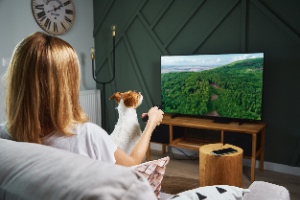
Dogs can watch TV, enjoying the moving images and sounds like human companions.
More...
Have you ever wondered if dogs can watch TV? Today, we delve into this fascinating subject, a concept that is gaining popularity among pet owners.
Understanding Dog Perception and Interaction With TV
1.) Pet Behavior
Believe it or not, dogs can watch TV and even show preferences for specific types of content. Unlike humans, dogs interact with TVs distinctly.
Their unique visual capabilities shape how they perceive moving images.
For example, modern TVs' higher frame rate better aligns with dogs' vision, making the experience more engaging for them.
Additionally, certain sounds and movements on the screen can capture their attention more effectively.
When selecting products for dogs, consider objects that enhance how dogs interact with TVs, such as comfortable pet beds positioned near the screen or toys that complement their viewing experience.
By understanding these factors, pet owners can select programs more likely to entertain and stimulate their furry friends.
2.) Animal Cognition
Recent research reveals that dogs can recognize images on TV. They respond actively to various visuals, particularly those featuring other animals or nature scenes.
With keen interest, they often engage with the screen, demonstrating their unique cognitive abilities.
This newfound understanding of canine perception opens up exciting possibilities for enhancing their mental stimulation and overall well-being.
Moreover, these insights pave the way for further studies on how dogs interact with digital media, offering a fascinating glimpse into their world.
Consequently, our appreciation for these intelligent companions continues to grow.

3.) Visual Stimulation for Dogs
Dogs, in particular, can watch TV and find it quite engaging.
The moving images and vibrant colors provide visual stimuli that keep them entertained and mentally stimulated.
Moreover, programs designed specifically for dogs can hold their attention longer, making TV time fun and beneficial.
Transitioning from one activity to another becomes more accessible when they have something intriguing to focus on.
So, next time you turn on the TV, consider selecting a dog-friendly channel to enrich your furry friend's day.
4.) Television Sound Effects on Dogs
Television sounds significantly influence dogs. Specific frequencies have the power to soothe them, transforming TV into an effective tool for alleviating anxiety.
For instance, calming music or nature sounds can create a peaceful environment, helping your dog relax.
Additionally, using TV during stressful events like thunderstorms or fireworks can distract and comfort your furry friend.
Integrating specific soundscapes into their routine may improve their overall well-being.
Remember, the proper audio selections can make a noticeable difference in your dog's stress levels and happiness.
5.) Pet-Friendly Programming
Several channels now offer programming specifically for dogs. The creators designed these shows to hold dogs' attention and cater to their viewing preferences.
Beyond regular channels, creators specifically design programs to entertain our canine friends. These often include scenes of wildlife and domestic animals.
Therefore, dogs can watch TV and enjoy these specially designed programs.
6.) Dogs Can Watch TV for Comfort
Dog TV has several benefits. It can help reduce loneliness and anxiety when pets are alone, providing soothing sounds and visuals.
Notably, channels like DogTV have pioneered creating content tailored explicitly for canine viewers. These programs aim to appeal to dogs' visual and auditory preferences.
For those interested in DIY solutions, creating engaging home videos can also keep pets happy and entertained.
7.) Animal Welfare
It's essential to consider how much screen time is healthy for a dog. Similar to humans, excessive screen time could lead to issues in pets.
Although screen time has advantages, excessive use may harm a pet's health and behavior.
Balancing these activities in our dog's daily lives is important to ensure a healthy mix of digital engagement, physical activity, and real-life social interactions.

8.) Interactive Dog Toys vs. Dog TV
While TV can offer some entertainment for dogs, interactive toys provide a more dynamic and engaging experience.
Besides, these playthings engage their intellect and promote physical exercise, which is essential for their holistic health.
In contrast to passive TV watching, interactive toys challenge dogs to think, solve problems, and stay active.
Furthermore, incorporating a variety of toys can prevent boredom and reduce anxiety.
While dog TV programs have perks, integrating interactive toys into your dog's routine offers a more comprehensive approach to keeping them entertained and healthy.
9.) Exploring Canine Cognition
Dogs can recognize various images on screens. Their cognitive skills allow them to differentiate between familiar and unfamiliar visuals, which is crucial in how they react to content.

10.) The Role of Visual Stimulation
Visual media is a captivating entertainment source for pets, particularly dogs. It grabs their attention and engages them in amusing and mentally stimulating ways.
To begin with, TV can enrich a dog's environment by presenting moving images and sounds, offering a break from routine and preventing boredom.
Subsequently, dynamic visuals can enhance cognitive functions, keeping their minds sharp and active.
Not to mention, TV programs can provide varied stimuli that hold a dog's interest and make it a valuable tool for their overall well-being by transitioning from one scene to another.
11.) Focusing on Dog Attention Span
Dogs exhibit different attention spans while watching television. To keep them engaged, owners must understand what captures their interest.
For instance, fast-moving visuals and sounds often hold their attention longer.
You can ensure your furry friend stays entertained by selecting content that aligns with these preferences.
Further, incorporating variety in the type of shows or videos can prevent boredom.
Similarly, just like humans, dogs appreciate a mix of excitement and relaxation in their TV time.
Consequently, paying attention to their reactions can guide you in curating the perfect viewing experience for them.
12.) Interactive Dog Toys Versus Dog TV
Comparing traditional interactive toys to dog TV shows reveals unique engagement benefits for each.
Firstly, interactive toys stimulate physical activity and mental sharpness, while dog TV offers visual and auditory stimulation that can soothe and entertain.
Moreover, by integrating these options, you create a holistic entertainment experience that keeps your pet active and relaxed.
This balanced approach ensures your dog enjoys varied activities, prevents boredom, and promotes overall well-being.
13.) Dogs Can Watch TV for Relaxation
Dog TV can offer numerous benefits, such as reducing anxiety or providing companionship for dogs when they are alone.
Interestingly, dogs can watch TV, which can be soothing and help them feel more relaxed and less isolated.
By closely adhering to these insights and considerations, pet owners can effectively use television as a constructive part of their dog's daily routine.
Consequently, this ensures it adds value rather than detracts from their well-being.
14.) The Role of Visual Stimulation
Visual media offers more than entertainment for our furry friends; it actively engages their minds.
In particular, for dogs, the dynamic movements and patterns on television can spark their instincts and curiosity.
Whenever they see fast-paced action or hear intriguing sounds, their attention is captivated, promoting mental stimulation.
Additionally, specific visuals can even mimic the behaviors of prey or other animals, making TV a fascinating experience for them.
Therefore, incorporating visual stimuli into your dog's routine can improve their overall mental well-being and happiness.
15.) Dogs Can Watch TV to Reduce Anxiety
Dog TV can significantly alleviate anxiety and offer companionship for dogs, especially those left alone at home for extended periods.
It is a distraction and a calming presence in an otherwise silent environment.
By recognizing these benefits, pet owners can make better choices about their pets' media habits.
This approach ensures that television entertains and enriches their dogs' lives.
Consequently, understanding canine interaction with TV allows for more thoughtful decisions, enhancing the well-being of our furry friends rather than diminishing it.
16.) Scientific Basis on Dogs Watching TV
Dogs see the world differently from humans. Their unique vision capabilities mean they experience television in a way we might find hard to imagine.
Moreover, dogs can watch TV and perceive moving images, though their understanding is limited.
Dogs have fewer color receptors and see colors like blue and yellow more vividly but struggle with reds and greens. Their strength lies in detecting motion, thanks to having a higher flicker sensitivity than humans.
Regarding cognitive responses, dogs can indeed recognize shapes and animals on TV.
Nonetheless, their comprehension mainly stems from detecting motion and audio rather than grasping the actual context of the events unfolding on the screen.

17. ) Interest and Engagement
Dogs are more captivated by TV shows showcasing natural landscapes and animals.
These elements grab a dog's attention far more effectively than urban settings or human-centric dramas, illustrating this point.
For instance, while watching, some dogs may bark excitedly at seeing other animals on the screen or wag their tails in delight.
On the other hand, others might ignore the program altogether.
Thus, TV content incorporating scenes from nature and featuring various animals can significantly enhance a dog's viewing experience and engagement.
18.) Benefits and Drawbacks
Television is an excellent mental stimulant for dogs, often reducing anxiety by keeping them entertained.
On the plus side, it can provide a welcome distraction when you're busy or away.
However, there are notable downsides. Excessive screen time may lead to overstimulation and divert their attention from essential physical activities.
This lack of exercise can negatively impact their overall health.
While TV can be beneficial in moderation, balancing screen time with plenty of outdoor play and interaction is crucial to ensure your dog's well-being.
19.) Optimizing Your Dog’s Tv-Watching Experience
Create a comfortable viewing nook for your dog by arranging a soft bed or blanket in a spot with an unobstructed screen view.
First and foremost, ensure the distance is safe to prevent eye strain.
To keep your furry friend engaged without overloading their senses, limit TV time to no more than an hour per day, broken into shorter sessions.
This balanced approach helps avoid excessive stimulation while allowing your dog to enjoy their favorite shows.
By paying attention to these details, you can enhance your dog's TV-watching experience and keep them happy and healthy.
20.) Dogs Enjoy TV but Need Playtime
Veterinarians and animal behaviorists agree that while some TV viewing can benefit dogs, it should never replace physical activities or interactive play.
They stress the importance of understanding each dog's unique personality and preferences to determine appropriate TV time.
Moreover, regular exercise and play keep dogs healthy and strengthen the bond between pets and their owners.
Hence, balance is vital; allow your dog to enjoy screen time, but always prioritize active engagement and outdoor adventures.

In the Final Analysis
Today, we explored how dogs perceive and interact with television, focusing on Dog TV.
To begin with, pet owners can access dog-friendly programs to entertain their pets.
Interestingly, studies show that dogs can watch TV and respond to screen images, often reacting to sounds and movements by barking at animals they see.
Surprisingly, some dogs even enjoy specific shows designed for them.
DogTV offers content tailored to keep dogs engaged and entertained.
Experts suggest specific colors and patterns attract a dog's attention more effectively.
Notably, many owners use TV to reduce separation anxiety in their pets.
Moreover, combining interactive toys with Dog TV can enhance the viewing experience.
Research indicates that dogs can watch TV without boredom if the content is varied.
Additionally, providing a comfortable viewing area enhances the experience for your pet.
Importantly, it's essential to consider volume levels since loud noises may startle your dog.
Starting with short sessions helps gauge interest and prevent overstimulation.
Finally, incorporating television into your dog's routine requires careful observation and adjustment.





